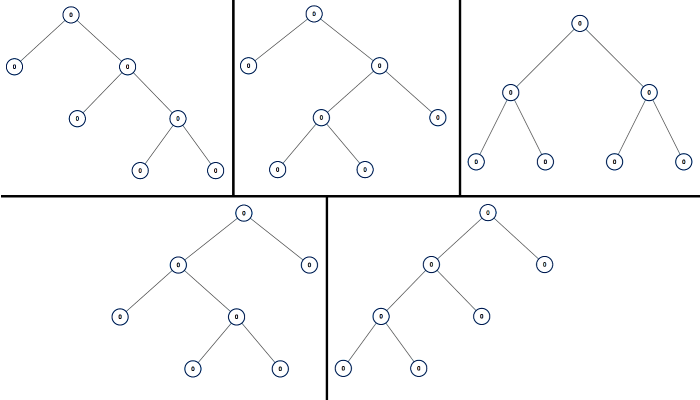原文链接: https://leetcode-cn.com/problems/all-possible-full-binary-trees
英文原文
Given an integer n, return a list of all possible full binary trees with n nodes. Each node of each tree in the answer must have Node.val == 0.
Each element of the answer is the root node of one possible tree. You may return the final list of trees in any order.
A full binary tree is a binary tree where each node has exactly 0 or 2 children.
Example 1:

Input: n = 7 Output: [[0,0,0,null,null,0,0,null,null,0,0],[0,0,0,null,null,0,0,0,0],[0,0,0,0,0,0,0],[0,0,0,0,0,null,null,null,null,0,0],[0,0,0,0,0,null,null,0,0]]
Example 2:
Input: n = 3 Output: [[0,0,0]]
Constraints:
1 <= n <= 20
中文题目
满二叉树是一类二叉树,其中每个结点恰好有 0 或 2 个子结点。
返回包含 N 个结点的所有可能满二叉树的列表。 答案的每个元素都是一个可能树的根结点。
答案中每个树的每个结点都必须有 node.val=0。
你可以按任何顺序返回树的最终列表。
示例:
输入:7 输出:[[0,0,0,null,null,0,0,null,null,0,0],[0,0,0,null,null,0,0,0,0],[0,0,0,0,0,0,0],[0,0,0,0,0,null,null,null,null,0,0],[0,0,0,0,0,null,null,0,0]] 解释:
提示:
1 <= N <= 20
通过代码
官方题解
方法:递归
思路与算法
令 $\text{FBT}(N)$ 作为所有含 $N$ 个结点的可能的满二叉树的列表。
每个满二叉树 $T$ 含有 3 个或更多结点,在其根结点处有 2 个子结点。这些子结点 left 和 right 本身就是满二叉树。
因此,对于 $N \geq 3$,我们可以设定如下的递归策略:$\text{FBT}(N) =$ [对于所有的 $x$,所有的树的左子结点来自 $\text{FBT}(x)$ 而右子结点来自 $\text{FBT}(N-1-x)$]。
此外,通过简单的计数参数,没有满二叉树具有正偶数个结点。
最后,我们应该缓存函数 $\text{FBT}$ 之前的结果,这样我们就不必在递归中重新计算它们。
[SVf3cp4a-Java]class Solution { Map<Integer, List<TreeNode>> memo = new HashMap(); public List<TreeNode> allPossibleFBT(int N) { if (!memo.containsKey(N)) { List<TreeNode> ans = new LinkedList(); if (N == 1) { ans.add(new TreeNode(0)); } else if (N % 2 == 1) { for (int x = 0; x < N; ++x) { int y = N - 1 - x; for (TreeNode left: allPossibleFBT(x)) for (TreeNode right: allPossibleFBT(y)) { TreeNode bns = new TreeNode(0); bns.left = left; bns.right = right; ans.add(bns); } } } memo.put(N, ans); } return memo.get(N); } }
[SVf3cp4a-Python]class Solution(object): memo = {0: [], 1: [TreeNode(0)]} def allPossibleFBT(self, N): if N not in Solution.memo: ans = [] for x in xrange(N): y = N - 1 - x for left in self.allPossibleFBT(x): for right in self.allPossibleFBT(y): bns = TreeNode(0) bns.left = left bns.right = right ans.append(bns) Solution.memo[N] = ans return Solution.memo[N]
复杂度分析
时间复杂度:$O(2^N)$,对于 $N$ 是奇数的情况,令 $N = 2k + 1$。然后,$\Big| \text{FBT}(N) \Big| = C_k$,第 $k$ 个卡特兰数(Catalan Number);以及 $\sum\limits_{k < \frac{N}{2}} C_k$(计算中间结果所涉及的复杂度) 限制在 $O(2^N)$内。但是,证明超出了本文的范围。
空间复杂度:$O(2^N)$。
统计信息
| 通过次数 | 提交次数 | AC比率 |
|---|---|---|
| 13747 | 17730 | 77.5% |
提交历史
| 提交时间 | 提交结果 | 执行时间 | 内存消耗 | 语言 |
|---|




